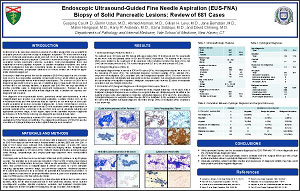Endoscopic Ultrasound-Guided Fine Needle Aspiration (EUS-FNA) Biopsy of Solid Pancreatic Lesions: Review of 681 Cases
Guoping Cai, M.D., Berrin Ustun, M.D., Ahmed Alomari, M.D., Gillian H. Levy, M.D., Jane Bernstein, M.D., Malini Harigopal, M.D., Harry R. Aslanian, M.D., Uzma Siddiqui, M.D., and David Chhieng, M.D.
Departments of Pathology and Internal Medicine, Yale School of Medicine, New Haven, CT, USA
INTRODUCTION
Solid lesions in the pancreas comprises a variety of entities ranging from non-neoplastic to neoplastic processes and from benign to malignant neoplasms. The most common malignancy is ductal adenocarcinoma, which accounts for more than 85% of all malignancies and is associated with poor prognosis. Commonly encountered benign or less aggressive neoplasms include pancreatic endocrine neoplasm, solid pseudopapillary tumor and intraductal mucinous papillary neoplasm. In addition metastatic neoplasms and hematopoietic malignancies may also secondarily involve the pancreas. Due to their diverse clinical characteristics, preoperative distinction of of these entities are crucial for appropriate clinical management.
Endoscopic ultrasound-guided fine-needle aspiration (EUS-FNA) biopsy has been increasingly used in the preoperative evaluation of pancreatic lesions, which allows an accurate diagnosis of pancreatic tumors with minimal complications. The success of EUS-FNA in diagnosing pancreatic lesions in general or individual types of pancreatic tumors are well documented in the cytology literature. It appears that EUS-FNA has high specificity or positive predictive valve in diagnosing pancreatic malignancies. However, there are variation in the sensitivity and indeterminate diagnosis rate. In addition the reported non-diagnostic rate is varied.
FNA diagnosis of most pancreatic lesions, particularly ductal adenocarcinoma, is often straightforward and requires only cytological evaluation. Ancillary studies such as immunocytochemistry and flow cytometry may be required for the work-ups of other pancreatic neoplasms as well as secondary malignancies. In these circumstances, procure-ment of additional aspirate material is crucial. On-site evaluation allows rapid evaluation of aspirate material at the endoscopy suite and thus help ensure adequate sampling and appropriate specimen triage. In this regard, rapid on-site evaluation improves diagnostic performance of EUS-FNA by reducing non-diagnostic and indeterminate rates.
In this study we retrospectively reviewed 681 cases of solid pancreatic lesions that were evaluated by EUS-FNA at our institution. The diagnostic performance of EUS-FNA and the correlation of cytological diagnoses with surgical follow-ups were analyzed.
©2012 Yale Department of Pathology. All rights reserved.
Any redistribution or reproduction of part or all of the contents in any form is prohibited. You may not, except with express written permission of the author or the Department of Pathology, distribute or commercially exploit the content, nor may you transmit it or store it in any other website or other form of electronic retrieval system, including use for educational purposes.
